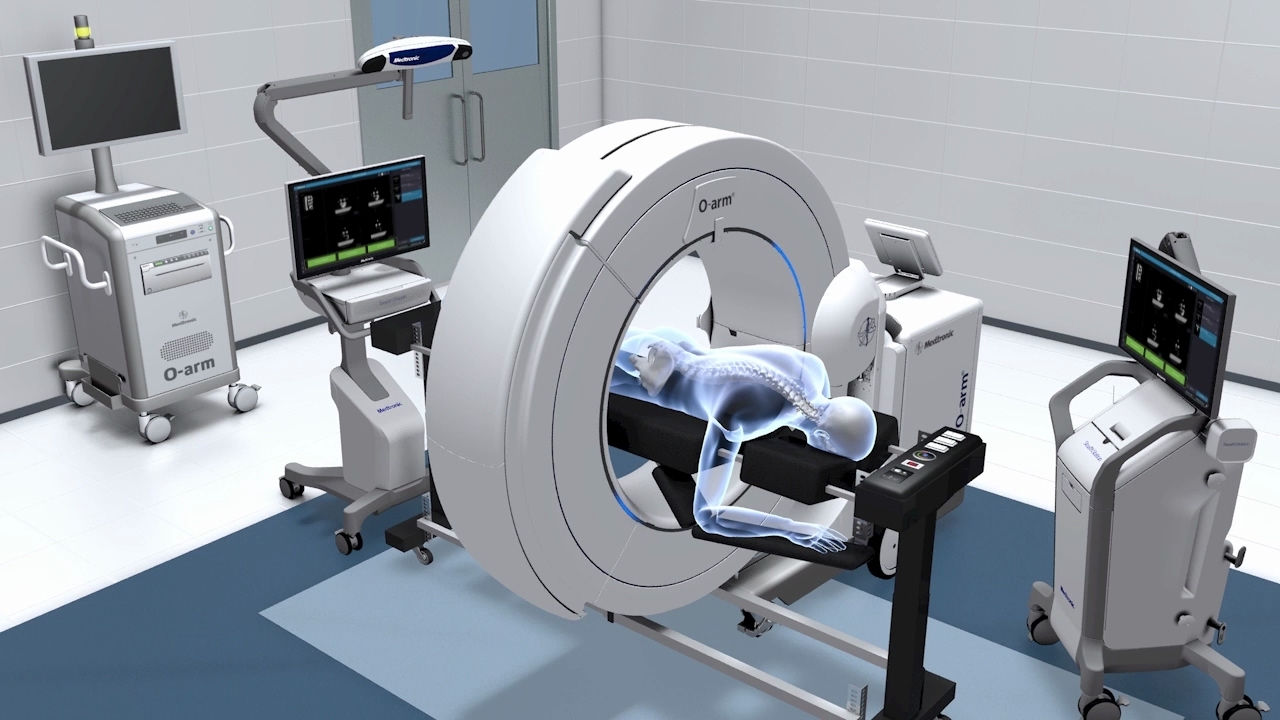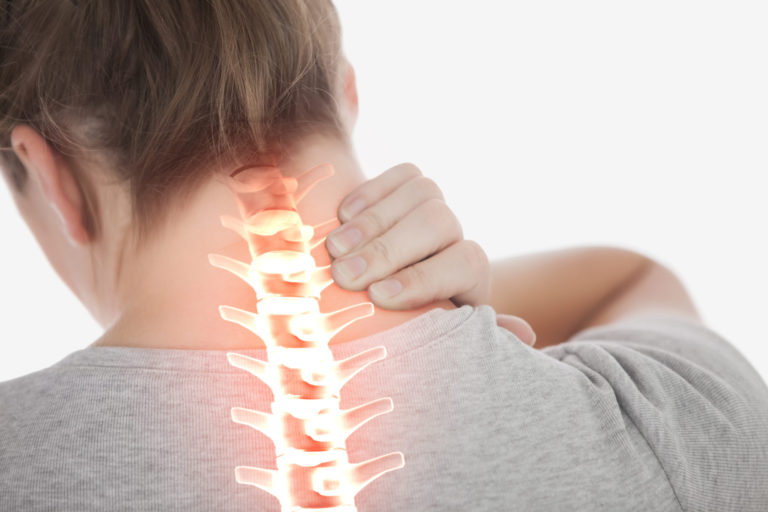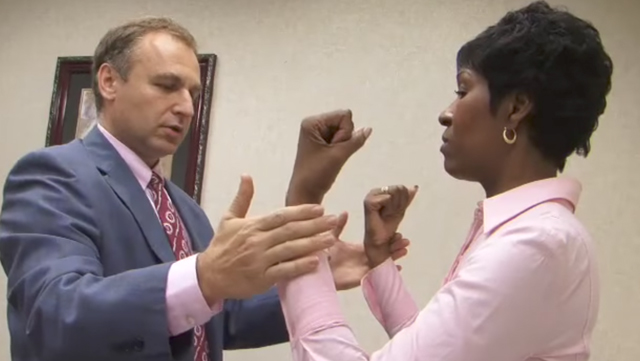Recent advancements in Spine surgery
Spine surgery has always been at the forefront of technology. I am delighted to announce the recent introduction of the Robotic assisted guidance and O-arm CT guided navigation. We are able to offer many of my patients these technologies thereby improving the safety of spine surgeries performed in the community. These are indeed exciting times for my spine patients as not only surgical safety has improved, but also length of stay and reduction of pain has also been positively affected by the additions of these tools.
Despite ever changing technology however, surgical skill, experience and judgment are the most important factors of achieving best outcomes! Patient safety and improved outcomes are always the primary goals of my practice. Thank you for allowing me the privilege of serving you and your families for over 22 years in practice.
Spine patients Hello!
Happy Fall! Enjoy the great weather with a brisk walk and don’t forget to stretch!

O ARM NEURONAVIGATION
Recent advances in Robotics and Neuronavigation are exiting. O-arm navigation allows the surgeon to perform an intraoperative CT scan to essentially obtain a “real time” visualization of the spine in order to more safely insert the spinal instrumentation. It also allows us to obtain a post surgical CT scan to ensure optimal positioning of the surgical hardware. Robotics can also assist with placement of the screws based on predetermined CT guided trajectories. These advance are making spinal surgery more safe to perform and more efficient in guidance and planning which ultimately may lead to better outcomes for our patients. These services are being offered to outpatients by Dr. Jebraili as we strive to remain at the forefront of cutting edge technology for our patients at Commonwealth Neurosurgery.

Hello world!
Spinal Fusion

Dr. Jebraili will recommend a spinal fusion treatment when the source of your back pain can be reasonably established radiographically by using imaging tests such as X-rays and MRI scans.
Am I A Candidate For Spinal Fusion?
Patients who experienced back pain or sciatica may be candidate for spinal fusion surgery. Typically these candidates are diagnosed with spinal stenosis, scoliosis, degenerative disk disease or spondylolisthesis. Tumors of the spine, fractures of the spine, spinal instability, recurrent disc herniation and other conditions may also be contributing factors which would require spinal fusion.
What Should I Expect During The Treatment?
There are various techniques used to perform a spinal fusion. Your surgeon may opt either for an anterior or posterior approach depending on your presenting radiology and overall condition. Dr. Jebraili aims to maximize your potential for recovery and rehabilitation through modern surgical techniques, early mobility and minimally invasive surgery techniques. Every patient’s condition is unique and he will make the appropriate recommendations accordingly.
Do I Need To Follow Any Special Instructions Following My Treatment?
Pain after a spinal fusion is a natural and expected part of your recovery process from surgery. Dr. Jebraili utilities an individualized post operative care plan consisting of some or all of the following: pain relievers, muscle relaxants, bracing, icing machine and postoperative physical therapy.
Since complete bone fusion may take from several months to a year, your surgeon will also recommend followup evaluation visits to monitor your healing process. This may involve followup spinal x-rays or other testing. As you recover, you will be able to increase your activity level and Dr. Jebraili will discuss your level of activity with you as you proceed with stages of recovery.
Contact our team at Commonwealth Neurosurgery to book an appointment or to obtain more information!
Anterior Cervical Discectomy and Fusion (ACDF)

Dr. Jebraili generally recommends cervical surgery to treat either spinal cord/nerve impingement or spinal instability. Decompression surgery and spinal fusion surgery are the two procedures used to treat these conditions. This operation is generally performed through the front of the neck (anterior approach) however there are conditions that require an approach through the back side of the neck (posterior approach.)
Am I A Candidate For Cervical Surgery?
Patients who are candidates for cervical surgery typically experience some or all of the following symptoms: neck pain, shooting pain down the arms or between shoulder blades, numbness, and tingling of the hand and arms, weakness of the upper extremity. In rare cases patients may experience difficulty with their balance and performing fine manual tasks. Common conditions that might necessitate surgical intervention would be cervical stenosis (narrowing of the spinal canal) due to herniated disks or bone spurs in the neck or misalignment of the spinal vertebrae in the neck.
The initial management of many of these conditions may include nonoperative measures including use of anti-inflammatory medications (NSAIDs) , muscle relaxants, activity modification, chiropractic care and physical therapy, interventional pain management through injections and alternative medicine including biofeedback and relaxation techniques, yoga and acupuncture. If the problem is more serious or does not lend itself to nonoperative measures based on your radiographic and clinical presentation, Dr. Jebraili may recommend spine surgery as the appropriate treatment.
What Should I Expect During The Treatment?
Your surgeon has the option of approaching your cervical spine from the back (posterior technique) or from the front (anterior technique) of your neck.
In most cases, surgeons opt for an anterior approach because it generally allows for maintaining proper alignment of the spine, less incisional pain and earlier postoperative rehabilitation and mobility.
Additionally, Dr. Jebraili will use surgical loupes or the operative microscope to provide optimal magnification and proper illumination during the surgery. The incision is typically less than 2 inches although it might vary depending on the number of levels involved. Dr. Jebraili encourages early mobility as much as possible including visit a of surgery. Patients receive postoperative antibiotics and painkillers. However, this operation is not very painful compared to other reconstructive spine surgery because of the limited amount of muscle dissection. Some patients experience pain in the throat from anesthesia intubation and surgery in the surrounding area. Voice rest, use of cough drops and soft food and liquids through for the first few days are recommended to minimize postoperative discomfort.
Do I Need To Follow Any Special Instructions Following My Treatment?
The majority of patients do not require any rigid bracing such as a cervical collar. Factors that may affect a patient’s outcome include their presenting neurological condition, duration of symptoms, severity of the radiology, age and other medical risk factors , type of employment and level of activity required postoperatively.
Dr. Jebraili will monitor your healing postoperative through followup evaluation as needed and x-rays over the course of your healing to ensure that your spine is properly healing. Some patients will also undergo postoperative physical therapy generally beginning about 2-3 weeks after their operation. Dr. Jebraili utilities an individualized post operative care plan consisting of some or all of the following: pain relievers, muscle relaxants, bracing, icing machine and postoperative physical therapy.
Minimally Invasive Spine Surgery

With modern advancements in spinal surgery, there have been successful attempts made at using minimally invasive techniques when treating back and neck conditions.
Minimally Invasive Spine Surgery, also known as less invasive spine surgery, utilizes smaller incisions to minimize dissection in the surrounding your surgical site. Smaller incisions also result in reduction in bleeding ,may minimize postoperative pain and allow for a faster recovery process and rehabilitation.
A current trend in minimally invasive spine surgeries is performing robotic-assisted and computer-assisted spine surgery. At Commonwealth Neurosurgery, using these techniques not only allows Dr. Jebraili to make smaller incisions but decrease exposure to radiation and enhance surgical accuracy.
Am I A Candidate For A Minimally Invasive Spine Surgery?
Dr. Jebraili will recommend you undergo spinal surgery if other non-surgical options such as physical therapy and medications have failed to relieve the pain symptoms caused by your spinal problems or if non-operative conditions are not deemed to be the most reasonable option or appropriate in the setting of your neurological presentation or radiographic findings.
Dr. Jebraili utilizes smaller incision, minimally invasive concepts of postoperative early rehabilitation and mobility to optimize the outcome of his patient’s.
What Should I Expect During The Treatment?
Your surgeon may use special instruments to perform minimally invasive spine surgery. After making a small incision, a retractor is inserted through your skin down to your spinal column. This is done to create a tunnel to the exact area the problem exists and to ensure the muscles are open and in place throughout the procedure. Surgeons use fluoroscopy to guide them when making the incisions and placing instrumentation. Fluoroscopy allows a surgeon to see “real time” x-ray images of your spine column on a screen during the surgery. To access your spine, your surgeon will use specialized instruments that can fit through the retractor. Any disks or bone material removed from your spine exits through the retractor and all devices required for fusion such as screws are introduced through the same tool. The final step involves removing the retractor to allow the muscles to return to their original position.
Do I need to follow any special instructions following my treatment?
Using minimally invasive techniques your hospital stay may be shortened to same day surgery or depending on the type of surgery, 1- 2 days of hospital stay. Post-operative pain may also be reduced with less tissue dissection and minimal invasive techniques.
Dr. Jebraili utilities an individualized post operative care plan consisting of some or all of the following: pain relievers, muscle relaxants, bracing, icing machine and postoperative physical therapy.
For any inquiries or to schedule an appointment with our qualified neurosurgeons, contact us at Commonwealth Neurosurgery, LLC today!
Lumbar Microdiscectomy

Depending on your neurological presentation and degree of radiographic abnormality, Dr. Jebraili may recommend non-surgical treatment to address the herniated disc, but in some cases, a lumbar discectomy is necessary.
Some indications for surgical intervention would be loss of strength, degree of disc herniation, duration of symptoms or the patient’s desire to return to a certain activity level as soon as possible. Each patient’s condition is unique and we encourage you to discuss your condition with Dr. Jebraili at the time of your visit.
Lumbar discectomy, also known as microdiscectomy, is a minimally invasive spine surgical procedure performed on the lower back to treat a herniated disc.
Dr. Jebraili utilizes minimally invasive techniques that often allow the patient to undergo outpatient surgery (same-day surgery).
During the procedure, a spine surgeon removes a small portion of your bone, over the nerve root or a portion of your intervertebral disc under the nerve root to relieve nerve compression, and provide maximum space for the nerve to heal.
Am I A Candidate For Lumbar Discectomy?
Your surgeon may recommend undergoing a lumbar discectomy if you have been diagnosed with spinal conditions which may be causing your lower back and leg pain also known as “sciatica”.
What Should I Expect During The Treatment?
Your surgeon makes a small incision, approximately 1 inch long over the spinal level (larger if multiple areas are involved), to be able to target the herniated disc and remove the herniated portion of the nerve root and surrounding neural elements.
Dr. Jebraili will wear surgical magnification loupes ,often combined with surgical microscope to help magnify and illuminate the disc that may be compressing your spinal nerves.
There may be a need to remove a portion of the lamina, which is a thin piece of bone covering the spinal cord, allowing the surgeon to better visualize the disc herniation.
Once the procedure is done, the small retractor is removed and your soft tissues move back into their expected place. Your surgeon will use sutures and staples to close the Incision.
Do I Need To Follow Any Special Instructions Following My Treatment?
Since this is a minimally invasive procedure, you may be up and walking within hours after your surgery. You may feel nauseous due to the anesthesia but this will fade away as the anesthesia wears off. Dr. Jebraili emphasizes to his patients that numbness is generally the last component of nerve recovery and often incomplete. Frequently some numbness is permanent .This is because of the variable recovery process of nerves in the spine which does not necessarily improve with surgery or medications.
Dr. Jebraili utilities an individualized post operative care plan consisting of some or all of the following: pain relievers, muscle relaxants, bracing, icing machine and postoperative physical therapy.
Spinal Reconstruction and Revision Spine Surgery

Spinal reconstruction involves addressing issues such as spinal stenosis and scarring that have resulted from prior surgery or expected “aging of the spine” which cannot be reasonably or safely addressed through a small incision anymore; abnormal curvature present in your spine (scoliosis); conditions such as spondylolisthesis where one vertebrae “slips over the other vertebrae” among other spinal issues.
Candidates for this type of surgery may experience symptoms such as loss of strength, pain, numbness,” tingling and pins and needles” in the legs and feet, or arms if the pathology is in the neck. Your surgeon may utilize x-ray, CT-scan or MRI to evaluate the level of pathology in the spine and severity of the radiographic finding before making medical recommendations .
The main goal of spinal reconstruction and revision is to address the neurological presentation of the patient and their radiographic pathology, to restore function and reduce pain as much as possible. Surgical intervention is necessary when nonsurgical measures have failed or the patient’s neurological and radiographic presentation indicates surgery to be the most appropriate option.
Am I A Candidate For Spinal Reconstruction & Revision Spine Surgery?
This type of operation requires special expertise in spinal instrumentation, bone grafting, fusion techniques and spinal decompression. Surgical experience is important in decision making and making recommendations to patients. At Commonwealth neurosurgery, Dr. Jebraili specializes in lumbar and cervical reconstructive spine surgery and revision spine surgery for patients who have previously undergone spinal surgeries. With over two decades of performing these types of surgeries, Dr. Jebraili is an expert in this field.
Patients who are candidates for reconstructive spine surgery often have previously undergone discectomies, laminectomies or other types of spine surgery. With expected natural aging of the spine, some of these patients will require additional reconstructive surgery even if there initial spine surgery was successful and provided years of pain relief. Some patients have not previously undergone any spine surgery but because of their MRI findings and clinical presentation, are offered this type of surgery.
Revision surgery may also be recommended for patients suffering from a “failed back syndrome” which is characterized by chronic pain after a spinal surgery.
Other indications for a spinal revision include excessive scar tissue forming around the nerves , recurrent disc re-herniation, infection, psudoarthrosis, spondylolisthesis and other surgical instability, spinal scoliosis and severe spinal stenosis.
What should I expect during the treatment?
Spine reconstruction involves undergoing spinal fusion surgery to provide more stability to your vertebrae.
Depending under condition, your surgeon may remove the affected disc between two vertebrae and then insert a disc spacer and bone graft in the existing disc space to support the disc space and stimulate bone growth. Once the new bone is formed, the goal is for the vertebrae to fuse together, limiting movement between these bones. Paradoxically, patients can gain range of motion and improvement in daily activity if their pain is reduced as a result of this surgery.
Utilizing minimally invasive techniques, smaller incisions are used to minimize blood loss and incisional pain.
Dr. Jebraili believes that a well-informed patient is mandatory in optimizing their recovery. Realistic expectations and goals must be part of the decision-making process in order to maximize the outcome of the operation. Dr. Jebraili emphasizes that typically these operations are not a “cure” but rather a repair of the damaged area of the spine. Lifelong commitment to reasonable activity modification, avoidance of extraneous activities and commitment to rehabilitation and proper exercise are very important to improve overall prognosis.
Do I need to follow any special instructions following my treatment?
Recovery after spine reconstruction surgery varies between patients, but mostly depends on your health and the specific type of treatment performed.
Dr. Jebraili utilities an individualized post operative care plan consisting of some or all of the following: pain relievers, muscle relaxants, bracing, icing machine and postoperative physical therapy.
Contact our team at Commonwealth Neurosurgery to book an appointment or to obtain more information!
Non-Operative & Operative Treatment of Neck & Back Pain

Fortunately most spine related issues do not require surgical intervention and can be managed with nonoperative treatment. This is why at Commonwealth Neurosurgery, Dr. Jebraili aims to treat his patients nonoperatively whenever possible.
In consulting with Dr. Jebraili, you are consulting with a Board Certified spine expert with over twenty years of experience. He will develop a detailed treatment plan, tailored specifically for you, taking into account a variety of factors which include your anatomy, physical exam, source, severity and duration of the pain and your imaging studies.
The main aim of managing neck and back pain is to maintain an ability to function properly, prevent any further injuries to the spine, and to provide adequate pain relief that will allow you to actively participate in your desired lifestyle.
Nonoperative options include but are not limited to judicious use of anti-inflammatory medications and muscle relaxants, activity modification, home exercise program to include stretching and core strengthening and isometric exercises, bracing, chiropractic care, physical therapy, yoga, alternative medical therapy including acupuncture and interventional pain management.
Nonsteroidal Anti-Inflammatory Drugs (NSAIDs)
NSAIDs are prescribed with a specific aim to minimize any inflammation in your joints or soft tissues. They may also be taken as short-term pain relievers. However, your physician will generally recommend short use of NSAIDs for management of spine conditions.
Steroids
These medications offer a strong anti-inflammatory effect. When taken, they offer temporary reduction of swelling, pain, inflammation, and stiffness associated with your soft tissues and joints. Not all patient are candidates for the use of steroids due to inherent side effects.
Muscle Relaxants
Your surgeon may recommend these medications to minimize muscle spasms which can otherwise cause stiff neck or back.
Analgesic Medications
These are what you may refer to as ‘pain killers’. They are used to minimize pain without necessarily changing the cause of the pain. The use of narcotic analgesics however is very limited in our practice. Their use prior to surgery if at all, would be limited to a very short course typically between 5-7 days. After surgery, they are used to manage surgical incision pain which generally does not exceed 1 or 2 weeks.
Physical Therapy
Depending on your condition, Dr. Jebraili may recommend physical therapy as a non-operative treatment option for neck and back pain. This can be either administered preoperatively or after an operation to maximize your recovery. It can be administered in several modalities such as:
- Hot Pack or Ice Pack
- Ultrasound
- Massage
- Traction
- Exercise
- Bracing
- Manual Manipulation
- TENS Units
- Core strengthening
- Work hardening
- Aqua therapy
Lifestyle Factors
Your surgeon may require that you make certain lifestyle changes to fully minimize the occurrence of lower back or neck pain. Some of the changes include weight loss, quitting smoking, enhanced ergonomics, and posture and activity modification.
If you have been experiencing severe back or neck pain that makes it difficult to function in your everyday life, contact Dr. Jebraili today at Commonwealth Neurosurgery for a tailored consultation.








